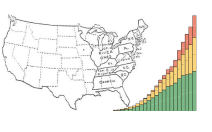Information published in the decennial census on the population by age and sex expanded from very little in 1790, when the White population was classified by sex and White males were classified as under 16 or 16 and over, to full detail in 1870, when data were published by sex by single year of age for the total population. For the White population from 1800 to 1820, the population was classified by sex and five age groups: under 10, 10-15, 16-25, 26-44, and 45+. This was expanded from 1830 to 1860 to a combination of five-year age groups (under 5 to 15-19) and ten-year age groups (20-29 to 90-99), and 100+. The Black population was not classified by age and sex (just by free and slave) until 1820 when the age groups were under 14, 14-25, 26-44, and 45+. The age detail was expanded in 1830 and 1840 to under 10, 10-23, 24-35, 36-54, 55-99, and 100+, after which the same detail was collected for the White and Black populations. Census data on the population on the population by age and sex are subject to various errors, including differences in net census undercount (traditionally higher for males, for young children, and for young adult males than for the remainder of the population) and to misstatement of age, including rounding to ages ending in 0 or 5. For further information, see Frank Hobbs (2004), “Age and Sex Composition,” Chapter 7 in The Methods and Materials of Demography. The median age, which is that age which divides the population into two equal groups (half younger and half older), has been calculated by linear interpolation based on the age data available. This assumption may introduce more error when the median is toward the middle of a large age span. In order to provide consistent time series of age data as far back as possible, some of the age data shown for years prior to 1870 have been estimated where this could be done with confidence that no significant error was being introduced. For 1830 to 1860, census data for ten-year age groups have been divided into five-year groups using osculatory interpolation. See Henry S. Shryock et al (1971), The Methods and Materials of Demography, Chapter 22 and Appendix C. For 1800 to 1820 for the White population, the population age 15 and age 25 was estimated in order to show data for the 15-24 and 25-44 age groups.
Figures
5-1. Median Age of the Population by Sex for the United States: 1800 to 2010
5-2. Percent Distribution of the Population by Broad Age Group for the United States: 1800 to 2010
5-3. Sex Ratio of the Population by Broad Age Group for the United States: 1800 to 2010
